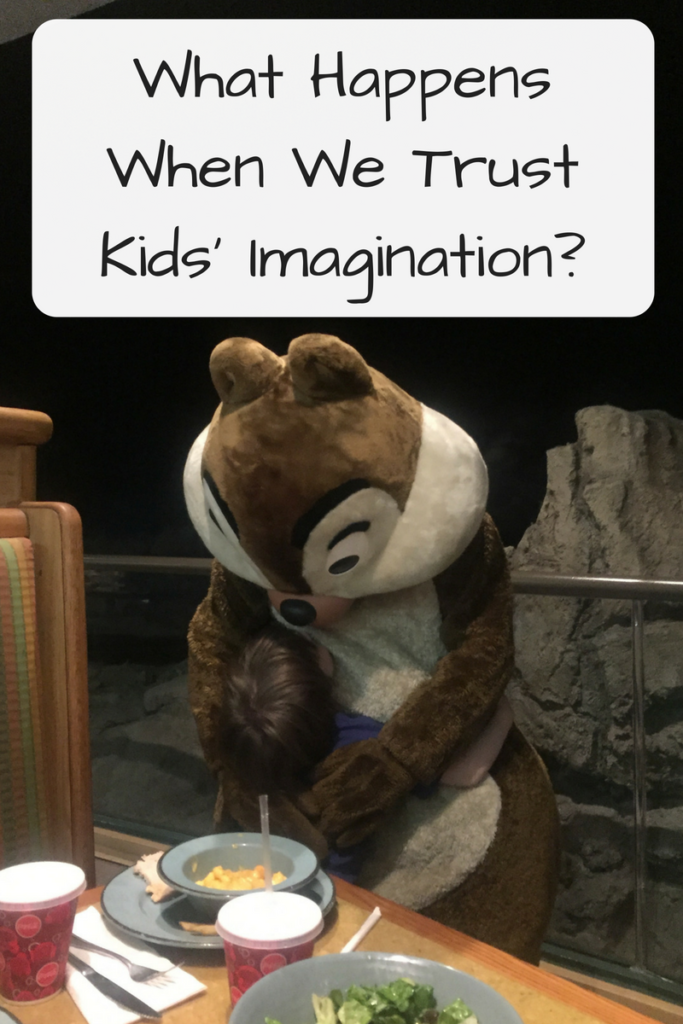
“They’re just people in costumes, right?” my four-year-old asked me about the Disney characters months before our trip to Walt Disney World. “Yep,” I answered, being truthful but not elaborating.
Yet despite knowing that, my son jumped up and down upon meeting them, hugging and high-fiving Chip, Dale, Pluto, and Mickey as they came to our table for a character lunch.
How did he manage that? I wondered. He knew they weren’t “real,” but his enthusiasm was genuine. I like “meeting” the characters too, but not with that level of joy. I’m always seeing layers down, wondering about who is in the costume or the logistics of it.
I think our responses reveal something important that most adults miss: kids can teach us so much about how to balance reality and imagination if only we let them.
As parents, we’re often obsessed with making childhood “magical.” From not giving away too much about Santa to placing Easter Bunny footprints, we’re in love with the idea of childhood whimsy. We worry that we’ve “ruined” things if we forget to slip money under the pillow from the Tooth Fairy one night.
But what if we don’t need to worry about that? What if all of the wonder we need is right in front of us?
We don’t need to create imaginary worlds for our children – they already carry them everywhere they go. Every time they talk to their stuffed animals, pretend they’re a dinosaur, or lick a toy ice cream cone, they’re practicing that balance between reality and fantasy. By hanging everything on that strict delineation between the two, we’re doing them a disservice. We’re telling them that once you “stop believing” in Santa that you lose his magic. We’re telling them that you need to have elaborate props and stories to create wonder. We’re telling them that imagination only has a specific time and place.
But we don’t have to tell our children these things. All we have to do is create a place they feel safe exercising their imagination. Cultivating that space doesn’t have to involve Pinterest and craft stores.
Instead, it’s much more about listening to your kids, asking questions during their stories, and entering their worlds. It’s about sharing your own favorite stories, both fiction and non-fiction. It’s reassuring them that it’s okay to cry because of a story – and letting them know that you do too. It’s following your kid’s lead when they play make-believe, even if it’s only for a few minutes. It’s letting them know that they too have a story to tell that means something.
This doesn’t need to look like one specific way of parenting. In fact, two children’s icons with very different philosophies expressed this beautifully.
Fred Rogers loved imagination, but he hated the idea of possibly tricking his young viewers. So his friends in the Land of Imagination were always clearly puppets, with Mr. Rogers controlling them.
In contrast, Jim Henson was a master of illusion. Even though I know the Muppets are puppets, they still feel real to me as an adult. If Mr. Rogers was the parent who tells their kid about Santa early but still addresses things to him anyway, Jim Henson is the parent who makes the world’s most elaborate Elf of the Shelf displays when the kids are 10.
Yet their work is beloved by children and adults alike. That’s because both of them respected imagination over illusion. The puppets didn’t matter nearly so much as the heart behind it.
So whether you’re a Mr. Rogers or a Jim Henson, just remember that it’s not what crafts you make or if you’ve accidentally let slip that the Tooth Fairy isn’t real. As long as you value wonder and imagination, your kids can still experience beautiful magic in the midst of reality.
For more on parenting, be sure to follow our Facebook page!